

RS Aggarwal Solutions Class 9 Maths Chapter 10: Chapter 10 of Class 9 Maths by RS Aggarwal is based on quadrilateral characteristics. Common quadrilaterals include the square, rectangle, rhombus, kite, parallelogram, and so forth. You will study the foundational theorems based on quadrilateral properties in this chapter.
The RS Aggarwal Solutions Class 9 Maths Chapter 10 will assist you in comprehending the most effective methods of tackling quadrilateral sum problems. These activities have been completed by our highly qualified instructors. Get the PDF from here for free.RS Aggarwal Solutions Class 9 Maths Chapter 10 PDF
The PDF that is provided below contains the solutions for RS Aggarwal Class 9 Maths Chapter 10 Quadrilaterals. All of the chapter's questions are answered in this PDF, which will aid in your understanding of the subjects. This resource can be very beneficial whether you're studying for an exam or just want to get your questions answered.RS Aggarwal Solutions Class 9 Maths Chapter 10 PDF
RS Aggarwal Solutions Class 9 Maths Chapter 10
Below are the answers to RS Aggarwal Class 9 Maths Chapter 10 Quadrilaterals. These solutions make it simpler for students to comprehend and resolve number system-related issues by offering detailed explanations for every question in the chapter.RS Aggarwal Solutions Class 9 Maths Chapter 10 Exercise 10.1
Question 1.
Solution:
Let, the measure of the fourth angle be X∘ Since the sum of the angle of a quadrilateral is 360∘, we have: 56 + 115 + 84 + X = 360 ⇒ 255 + X = 360 ⇒ X = 105 Hence, the measure of the fourth angle is 105.Question 2.
Solution:
Let, ∠A = 2X Then ∠B=(4X) ∠C=(5X) and ∠D=(7X) Since the sum of the angles of a quadrilateral is 360∘, we have: 2X + 4X + 5X + 7X = 360 18X = 360∘ ⇒ X = 20∘ Therefore, Angle A = 40∘ Angle B = 80∘ Angle C = 100∘ Angle D = 140∘Question 3.
Solution:
We have AB∥DC Angle A and Angle D are the interior angles on the same side of the transversal line AD, whereas angle B and Angle C are the same interior angles on the same side of transversal line BC. Now, Angle A + Angle D = 180∘ ⇒ ∠D = 180∘ – ∠A Therefore, ∠D = 180∘ – 55∘ = 125∘ Again, ∠B + ∠C = 180∘ ⇒ ∠C = 180∘ – ∠B Therefore, ∠C = 180∘ – 70∘ = 110∘Question 4.
Solution:
ABCD is a square in which AB = BC = CD = DA. ΔEDC is an equilateral triangle in which ED = EC = DC ∠EDC = ∠DEC = ∠DCE = 60∘ . To prove: AE = BE and ∠DAE = 15∘ Proof: In ΔADE and ΔBCE, we have: AD = BC [Sides of a square] DE = EC [Sides of an equilateral triangle] ∠ADE = ∠BCE = 90∘ + 60∘ = 150∘ ΔADE ≅ ΔBCE i.e., AE = BE Now, ∠ADE = 150∘ DA = DC [Sides of a square] DC = DE [Sides of an equilateral triangle] So, DA = DE ΔADE and ΔBCE are isosceles triangles. i.e., ∠DAE = ∠DEA = 1/2(180∘−150∘) = 30∘/2 = 15∘Question 5.
Solution:
A quadrilateral ABCD, in which BM ⊥ AC and DN ⊥ AC and BM = DN To prove: AC bisects BD, or DO = BO Proof: Let, AC and BD intersect at O Now, in ΔOND and ΔOMB, we have: ∠OND = ∠OMB (90∘ each) ∠DON = ∠BOM (Vertically opposite angles) Also, DN = BM (Given) i.e., ΔOND ≅ ΔOMB (AAS congruence rule) Therefore, OD = OB (CPCT) Hence, AC bisects BDQuestion 6.
Solution:
Given: ABCD is a quadrilateral in which AB = AD and BC = DC (i) In ΔABC and ΔADC, we have: AB = AD (Given) BC = DC (Given) AC is common i.e., ΔABC ≅ ΔADC (SSS Congruence rule) Therefore, ∠BAC = ∠DAC and ∠BCA = ∠DCA (By CPCT) Thus, AC bisects ∠A and ∠C (ii) Now, in ΔABE and ΔADE, we have: AB = AD (Given) ∠BAE = ∠DAE (Proven above) AE is common. Therefore, ΔABE ≅ ΔADE (SAS congruence rule) ⇒ BE = DE (By CPCT) (iii) ΔABC ≅ ΔADC (Proven above) Therefore, Angle ABC = Angle ADC (By CPCT)Question 7.
Solution:
Let, ABCD be a parallelogram ∠ A = ∠ C and ∠ B = ∠ D (Opposite angles) Let ∠ A be the smallest angle whose measure is x° ∴ ∠B = (2x – 30)° Now, ∠ A + ∠ B = 180° (Adjacent angles are supplementary) ⇒ x + 2x – 30° = 180° ⇒ 3x = 210° ⇒ x = 70° ∴ ∠B = 2 x 70°- 30° = 110° Hence, ∠ A = ∠ C = 70°; ∠ B = ∠ D = 110°| CBSE Class 9 Maths Syllabus | CBSE Class 9 Science Syllabus |
| CBSE Class 9 Computer Application Syllabus | CBSE Class 9 Social Science Syllabus |
Question 8.
Solution:
Let, ABCD be a quadrilateral whose diagonals are AC and BD and O is any point within the quadrilateral Join O with A, B, C, and D We know that the sum of any sides of a triangle is greater than the third side So, in ΔAOC, OA + OC > AC Also, ΔBOD, OB + OD > BD Adding these inequalities, we get: (OA + OC) + (OB + OD) > (AC + BD) ⇒ OA + OB + OC + OD > AC + BDQuestion 9.
Solution:
Given: ABCD is a quadrilateral and AC is one of its diagonals (i) In ΔABC, AB + BC > AC . . . . . . . . (1) In ΔACD, CD + DA > AC . . . . . . . . . . (2) Adding inequalities (1) and (2), we get: AB + BC + CD + DA > 2AC (ii) In ΔABC, we have : AB + BC > AC . . . . . . . . (1) We also know that the length of each side of a triangle is greater than the positive difference of the the other two sides. In ΔACD, we have: AC > |DA–CD| . . . . . . . (2) From (1) and (2), we have: AB + BC > |DA–CD| ⇒ AB + BC + CD > DA (iii) In ΔABC, AB + BC > AC In ΔACD, CD + DA > AC ΔBCD, BC + CD > BD ΔABD, DA + AB > BD Adding these inequalities, we get: 2 (AB + BC + CD + DA) > 2 (AC + BD) ⇒ (AB + BC + CD + DA) > (AC + BD)Question 10.
Solution:
Let ABCD be a quadrilateral and ∠1, ∠2, ∠3 and ∠4 are its four angles as shown in the figure. Join BD which divides ABCD in two triangles, ΔABD and ΔBCD. In ΔABD, we have: ∠ 1 + ∠ 2 + ∠ A = 180° . . . . . . . . (i) In ΔBCD, we have: ∠ 3 + ∠ 4 + ∠ C = 180° . . . . . . . (ii) On adding (i) and (ii), we get: (∠1 + ∠3) + ∠A + ∠C + (∠ 4 + ∠2) = 360° ⇒ ∠ A + ∠ C + ∠ B + ∠ D = 360° (Since,∠ 1 + ∠ 3 = ∠ B; ∠ 4 + ∠ 2 = ∠ D) ∴ ∠ A + ∠ C + ∠ B + ∠ D = 360°RS Aggarwal Solutions Class 9 Maths Chapter 10 Exercise 10.2
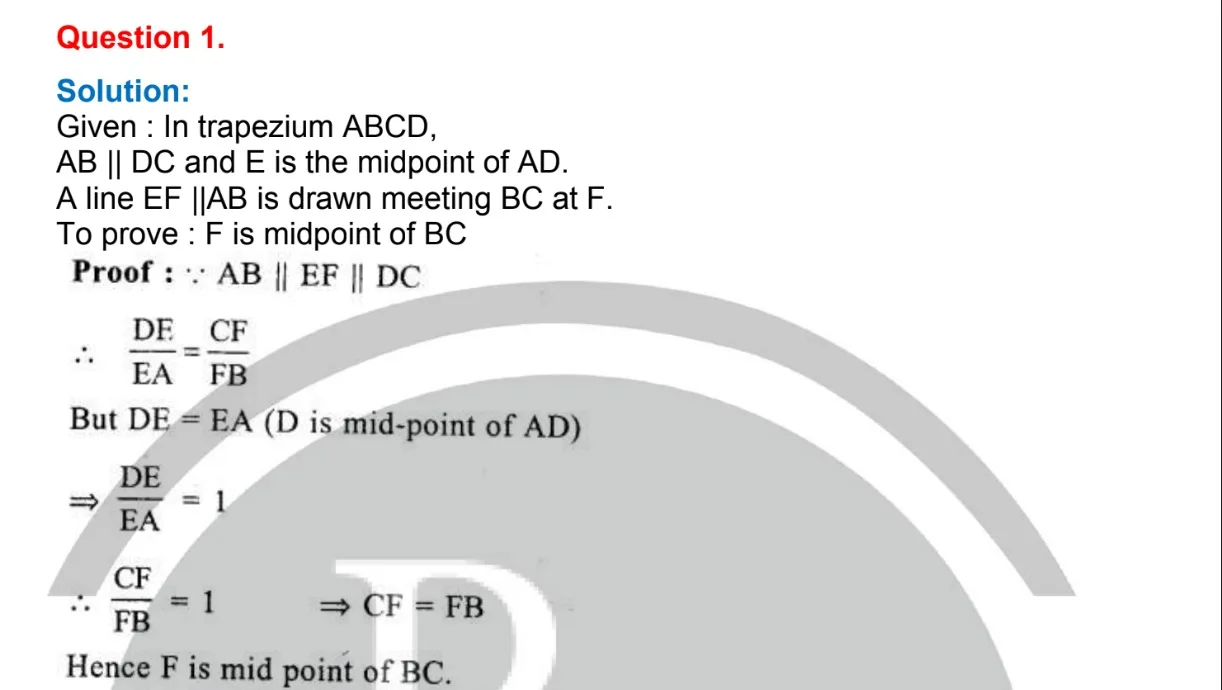
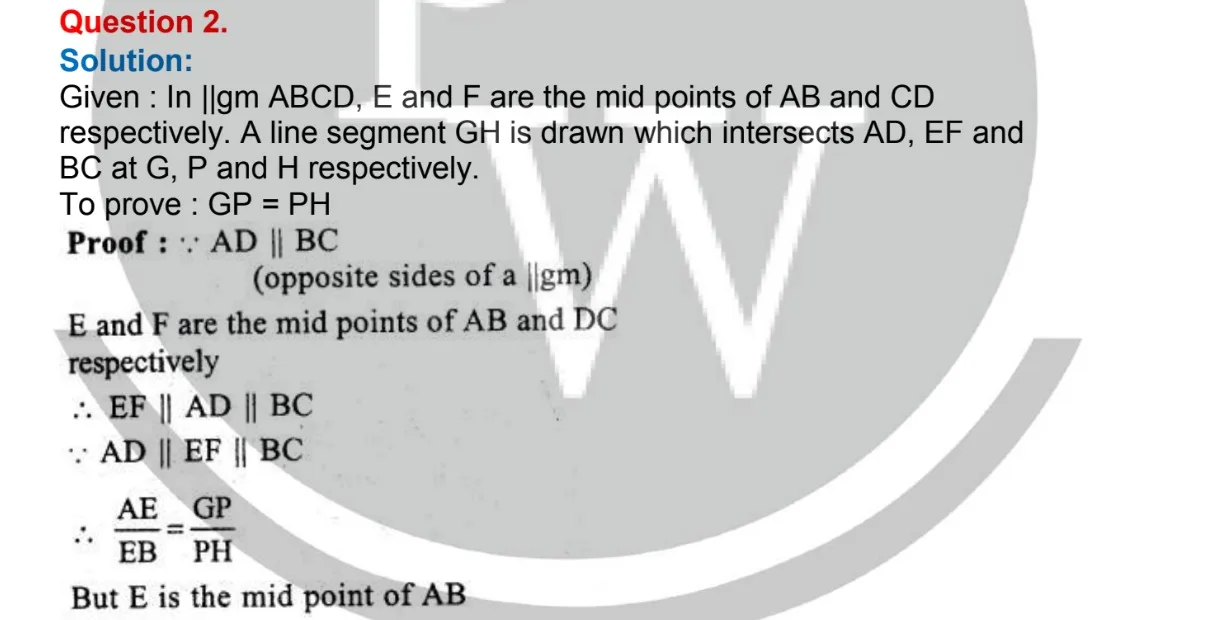

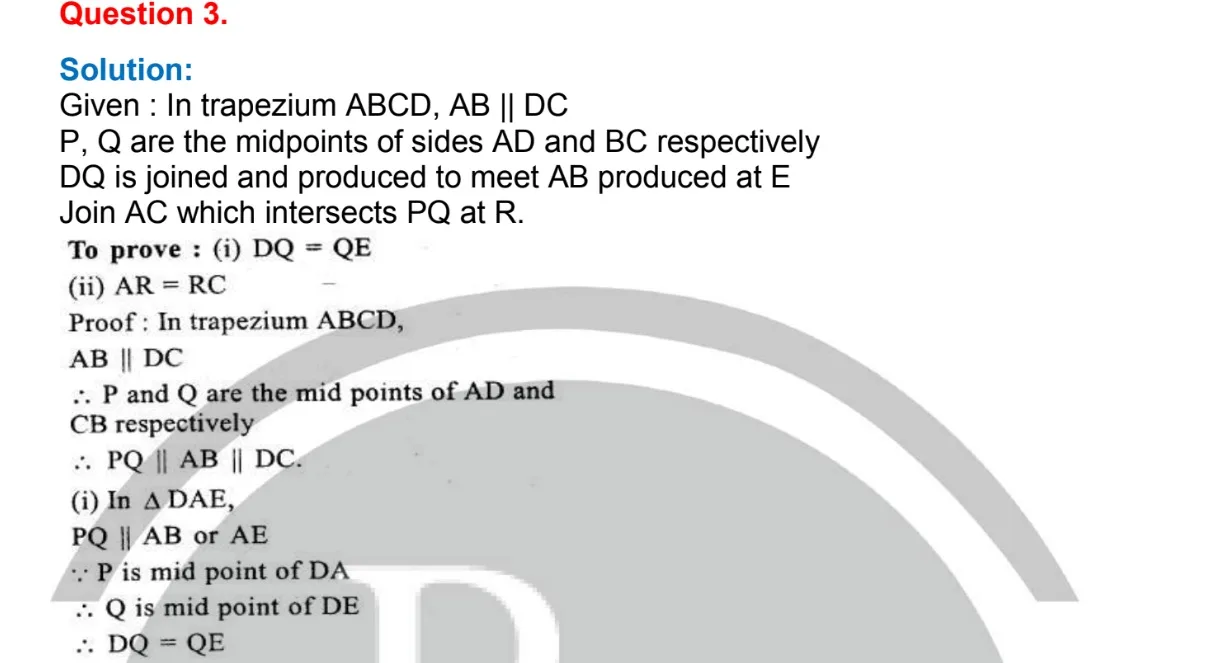

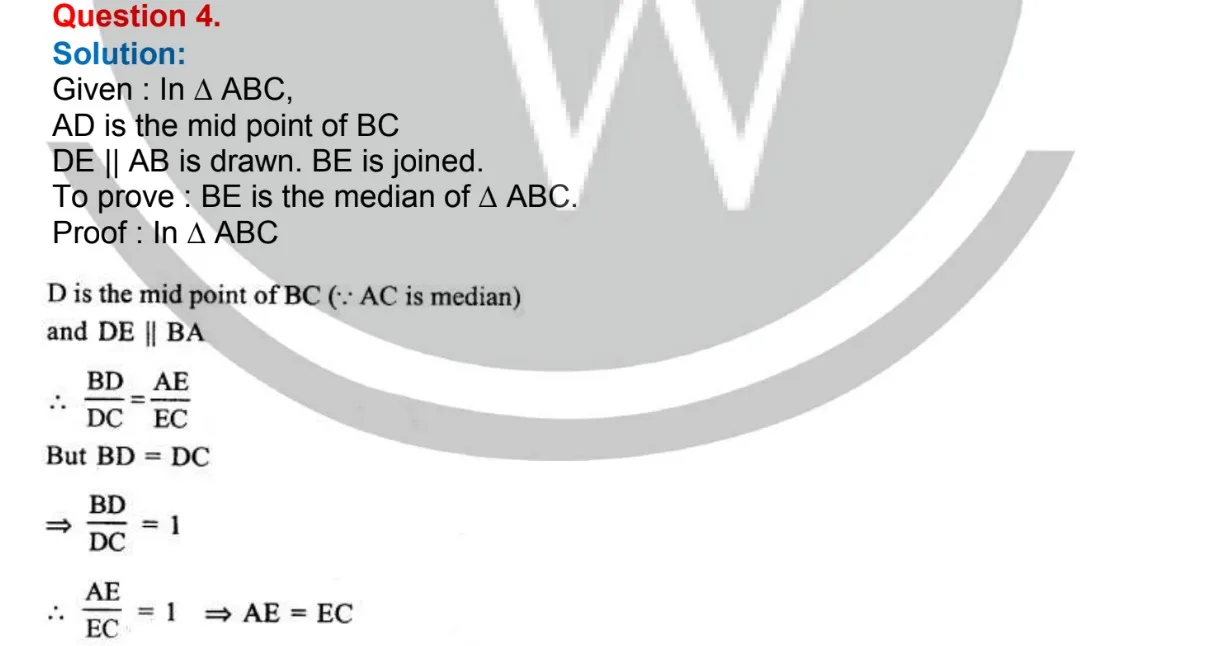
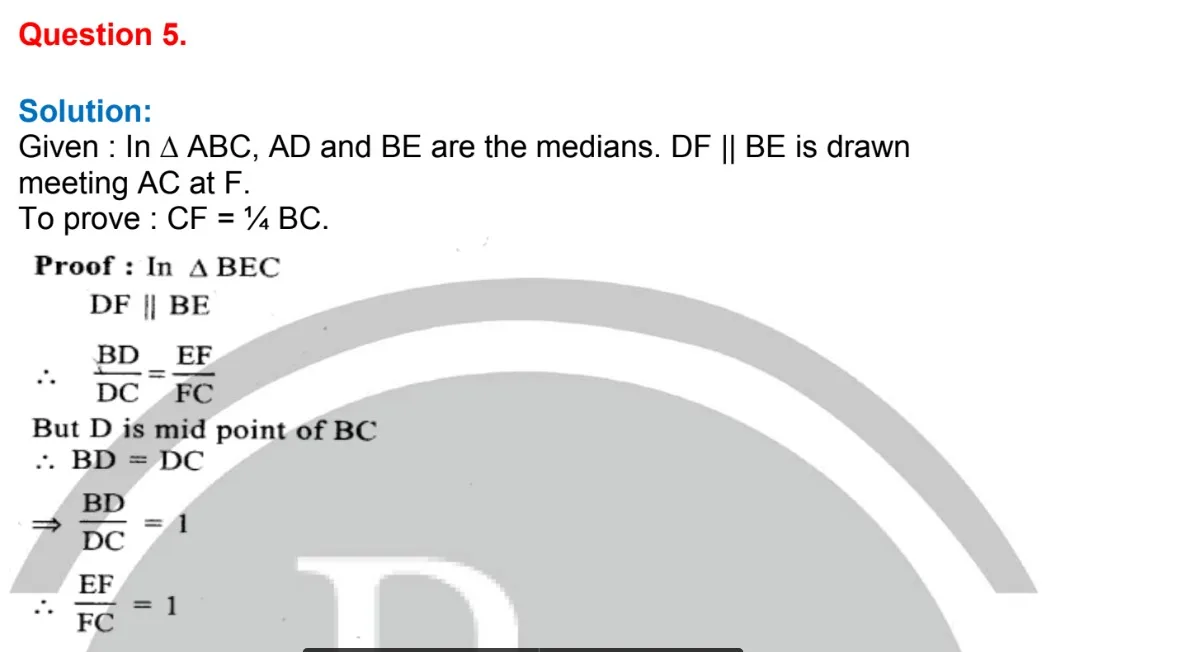

Question 6.
Solution:
Given : In ||gm ABCD, E is mid point of DC. EB is joined and through D, DEG || EB is drawn which meets CB produced at G and cuts AB at F. To prove : (i)AD = 1⁄2 GC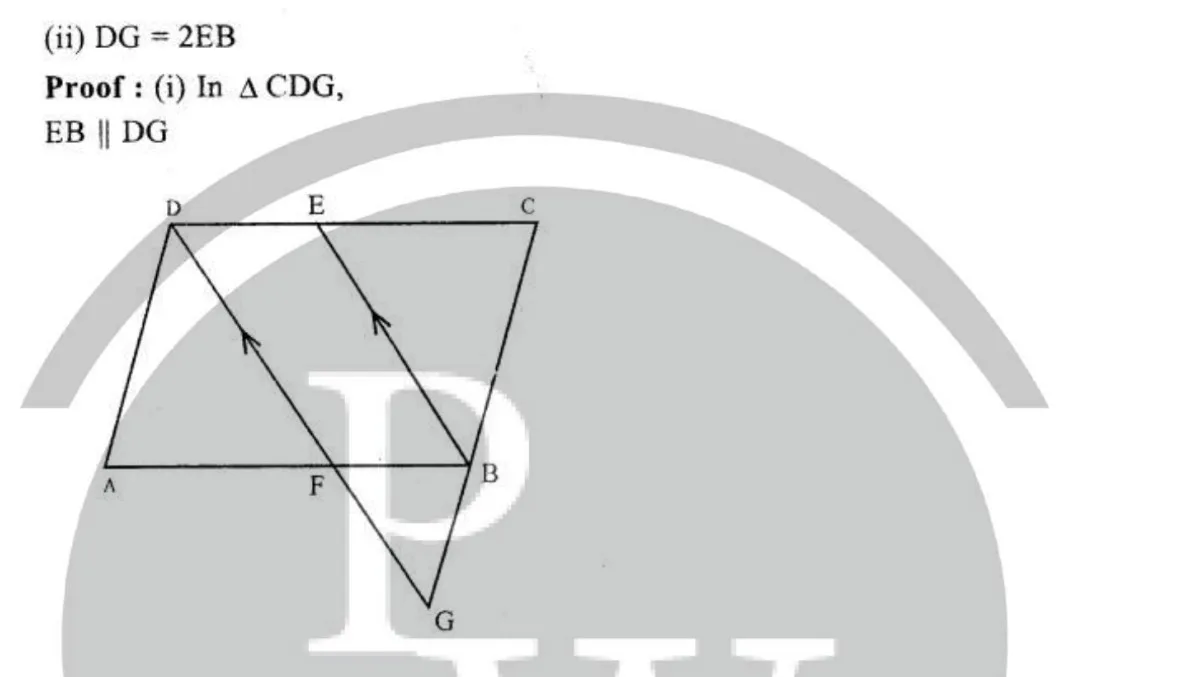
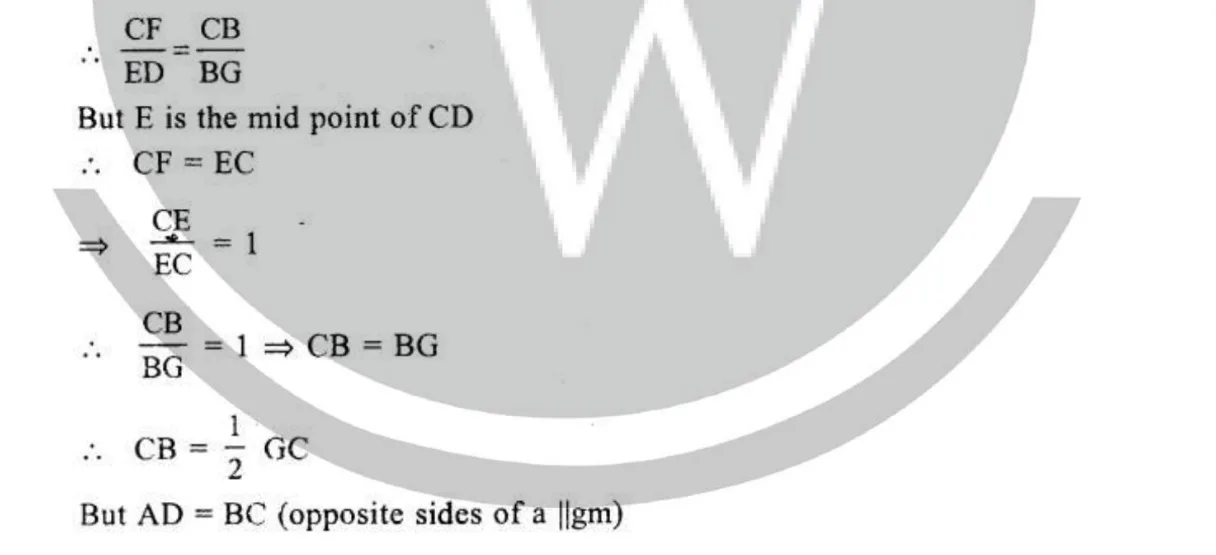
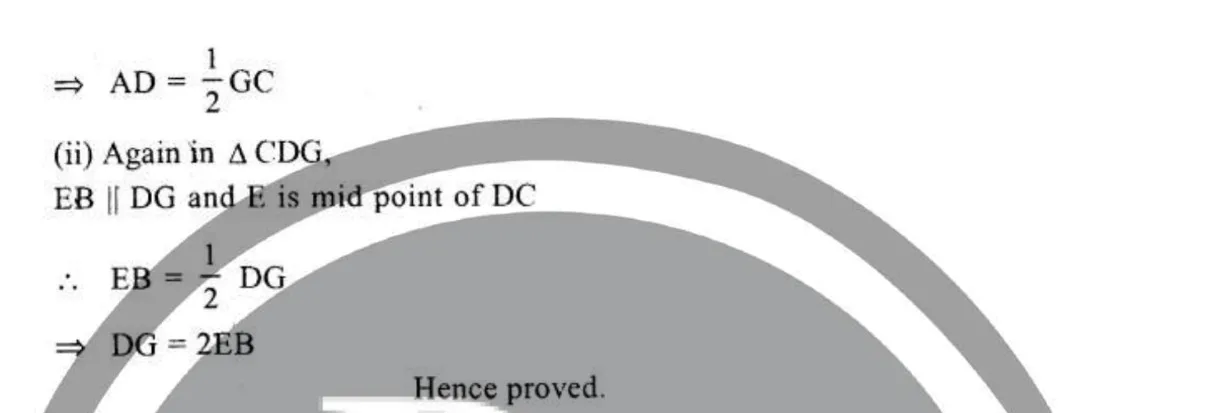
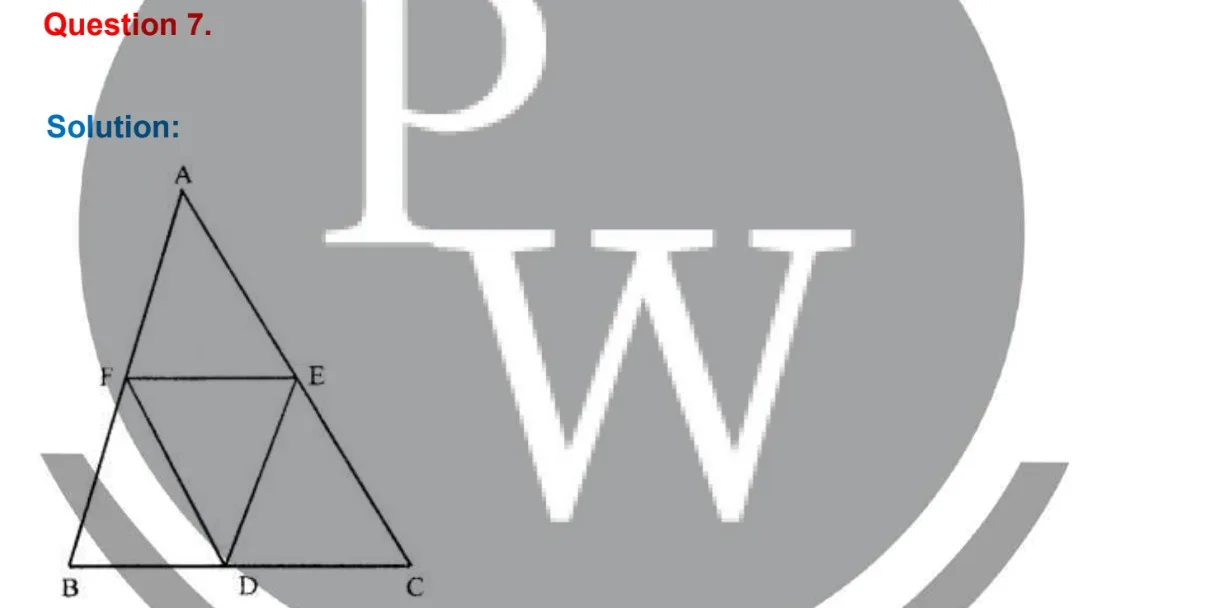
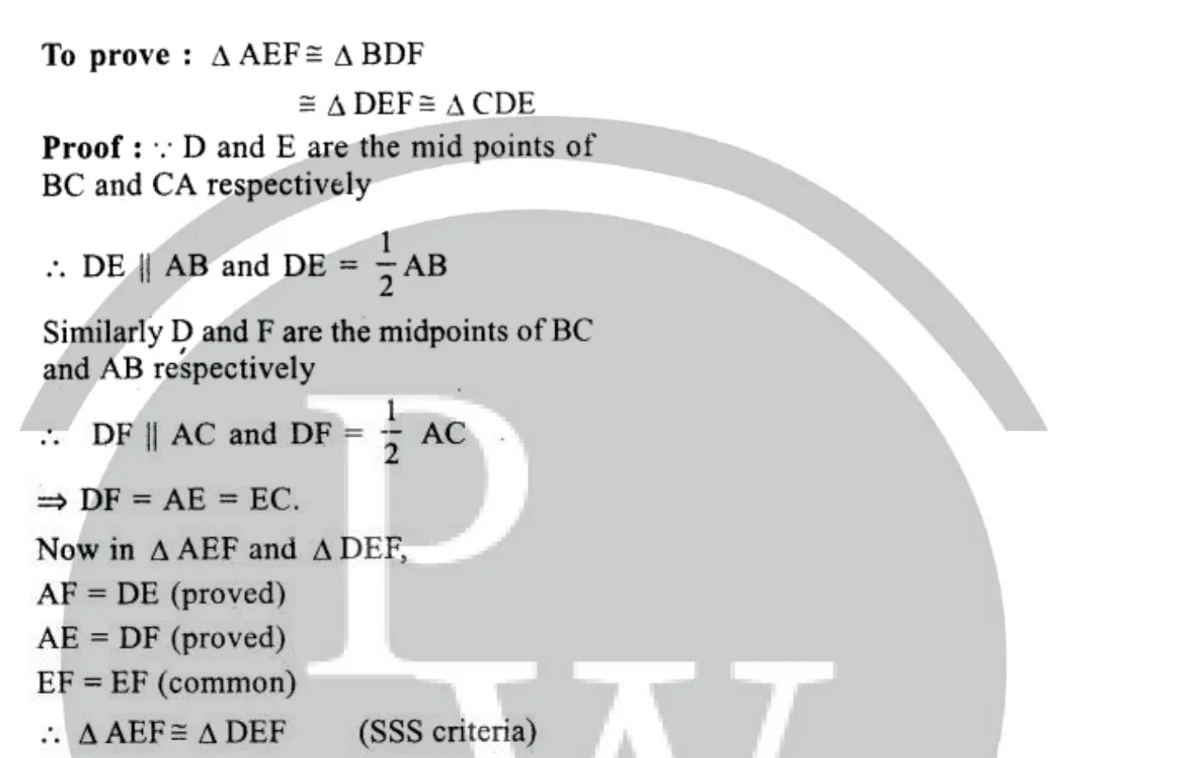
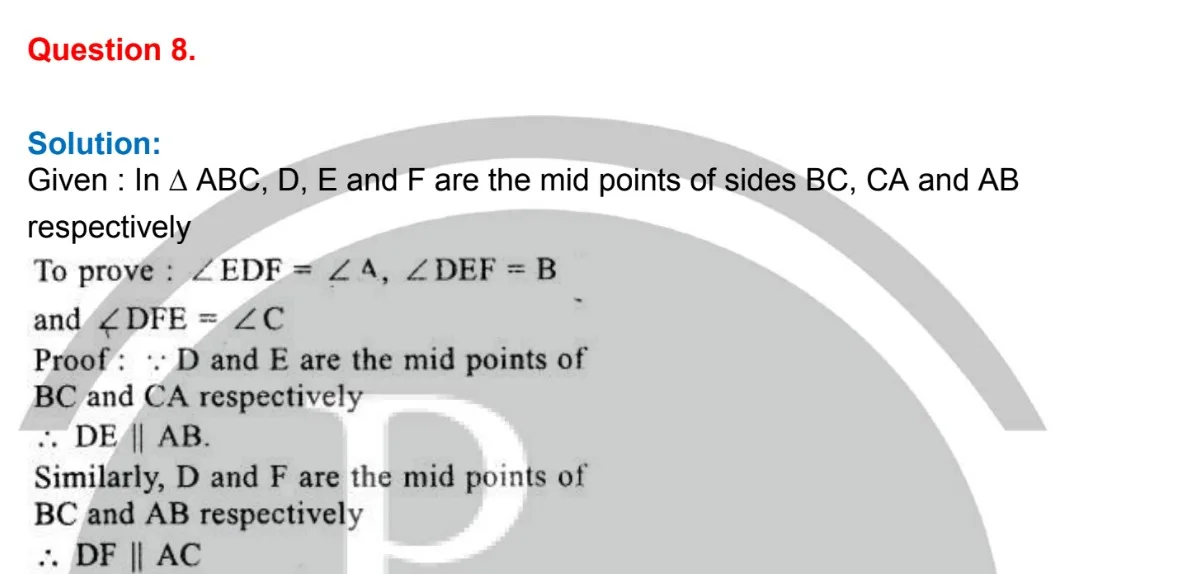


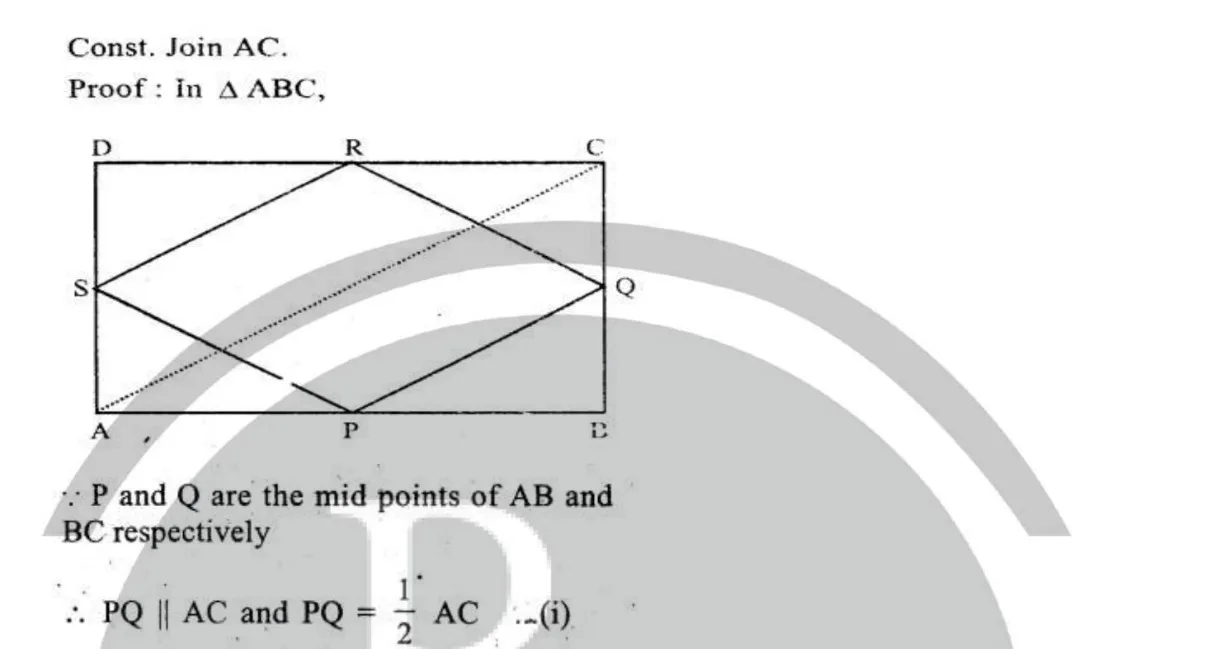
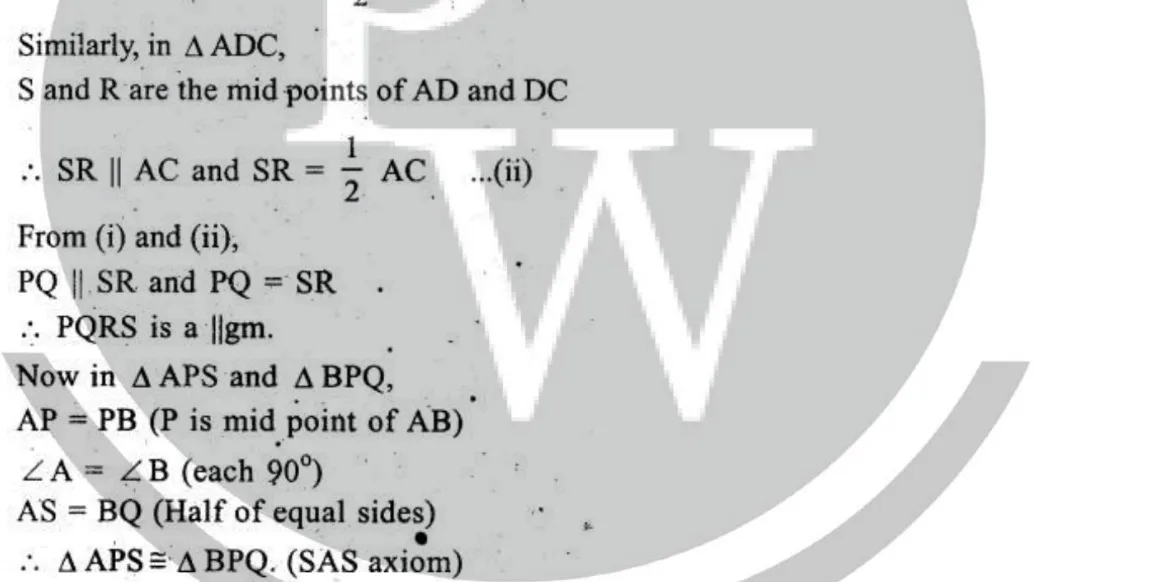
RS Aggarwal Solutions Class 9 Maths Chapter 10 Exercise 10.3
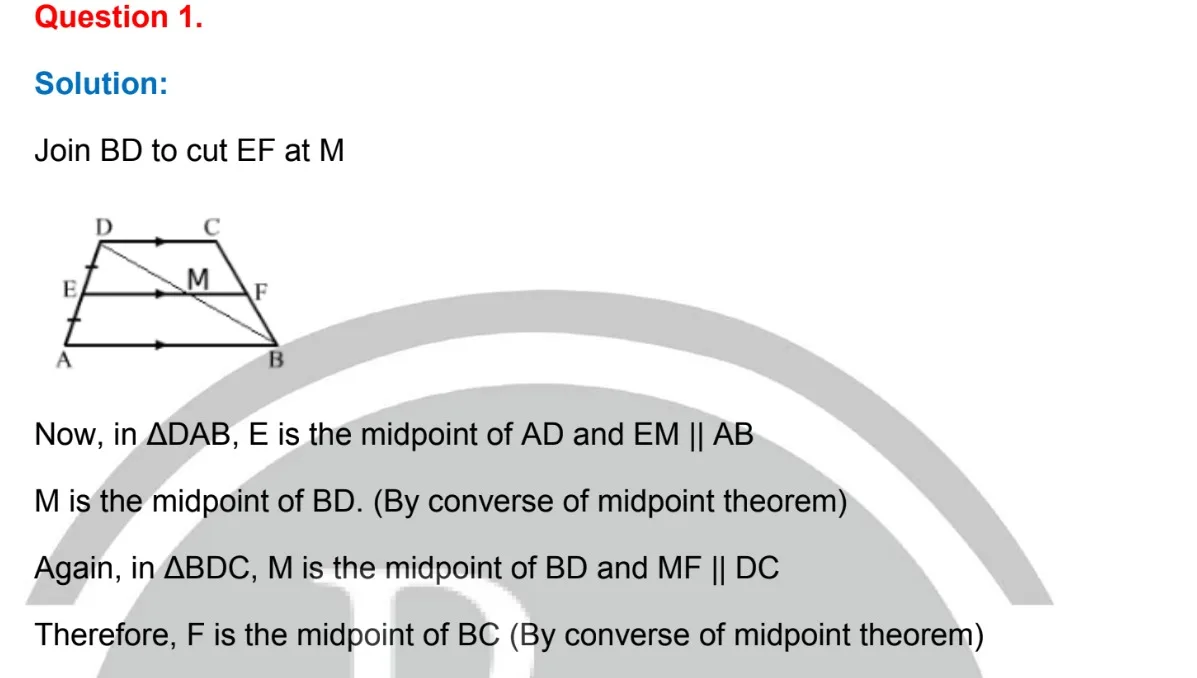
Question 2.
Solution:
In parallelogram ABCD, we have: AD || BC and AB || DC AD = BC and AB = DC AB = AE + BE and DC = DF + FC AE = BE = DF = FC Now, DF = AE and OF || AE. i.e., AEFD is a parallelogram. AD || EF Similarly, BEFC is also a parallelogram. EF || BC and AD || EF || BC Thus, AD, EF and BC are three parallel lines cut by the transversal line DC at D, F and C, respectively such that DF = FC. These lines AD, EF and BC are also cut by the transversal AB at A, E and B, respectively such that AE = BE Similarly, they are also cut by GH Therefore, GP = PH (By intercept theorem)Question 3.
Solution:
Given: AB || DC, AP = PD and BQ = CQ (i) In ΔQCD and ΔQBE, we have: ∠DQC = ∠BQE (Vertically opposite angles) ∠DCQ = ∠EBQ (Alternate angles, as AE || DC) BQ = CQ (P is the midpoints) ΔQCD =ΔQBE Hence, DQ = QE (CPCT) (ii) Now, in ΔADE, P and Q are the midpoints of AD and DE, respectively. PQ || AE, PQ AB || DC and AB || PR || DC (iii) PQ AB and DC are the three lines cut by transversal AD at P such that AP = PD. These lines PQ, AB, DC are also cut by transversal BC at Q such that BQ = QC. Similarly, lines PQ, AB and DC are also cut by AC at R. Therefore, AR = RC (By intercept theorem).Question 4.
Solution:
AD is a median of ΔABC and BD = DC We know that the line drawn through the midpoint of one side of a triangle and parallel to another side bisects the third side. Here, in ΔABC, D is the midpoint of BC and DE || BA (given). Then DE bisects AC. i.e., AE = EC E is the midpoint of AC Therefore, BE is the median of Δ ABCQuestion 5.
Solution:
In ΔABC, we have: AC = AE + EC . . . . . . (i) AE = EC . . . . . . (ii) [BE is the median of ABDC] AC = 2EC . . . . . . . (iii) In Δ BEC, DF || BE. EF = CF (By midpoint theorem, as D is the midpoint of BC) But EC = EF + CF EC = 2 (CF) . . . . . . (iv) From (iii) and (iv), we get: AD = 12 GC In ADCG, DG || EB and E is the midpoint of DC and B is the midpoint of GC. By midpoint theorem, the line segment joining the mid points of any two sides of a triangle is parallel to the third side and is half of it. i.e., EB = 12DG DG = 2 (EB)Question 6.
Solution:
Δ ABC is shown in the figure D, E and F are the midpoints of sides AB, BC and CA, respectively As, D and E are the mid points of sides AB, and BC of Δ ABC DE || AC (By midpoint theorem) Similarly, DF || BC and EF || AB Therefore, ADEF, BDFE, and DFCE are all parallelograms. Now, DE is the diagonal of the parallelogram BDFE. Δ BDE = Δ FED Similarly, DF is the diagonal of the parallelogram ADEF. Δ DAF = Δ FED And, EF is the diagonal of the parallelogram DFCE. Δ EFC = Δ FED. So, all the four triangles are congruent.Question 7.
Solution:
Δ ABC is shown below. D, E and F are the midpoints of sides BC, CA and AB, respectively. As F and E are the mid points of sides AB and AC of Δ ABC. FE || BC (By mid point theorem) Similarly, DE || FB and FD || AC Therefore, AFDE, BDEF, and DCEF are all parallelograms. In parallelogram AFDE, we have: ∠A = ∠EDF (Opposite angles are equal) In parallelogram BDEF, we have: ∠B = ∠DEF (Opposite angles are equal) In parallelogram DCEF, we have: ∠C = ∠DFE (Opposite angles are equal)Benefits of RS Aggarwal Solutions Class 9 Maths Chapter 10
This is the PDF for the RS Aggarwal Class 9 Maths Solutions. Students will gain a great deal from this in terms of timely revision and exam preparation. Before entering board class, pupils must complete a significant portion of their lives in class nine. Each chapter's solutions are given succinctly, and downloading the PDF offline to your PC is a helpful feature. One of the best things about this book is that it covers a wide range of problems, from easy, conceptual ones that don't require much thought to difficult ones that take a lot of the student's time. The difficult problems are answered in easy-to-understand steps with an explanation. As a result, this guarantees that students will learn a great deal from each question they answer and will boost their confidence for both current school tests and upcoming entrance examinations.RS Aggarwal Solutions Class 9 Maths Chapter 10 FAQs
Which is better RS Aggarwal or RD Sharma?
How to study quadrilaterals Class 9?
Is RS Aggarwal important?












